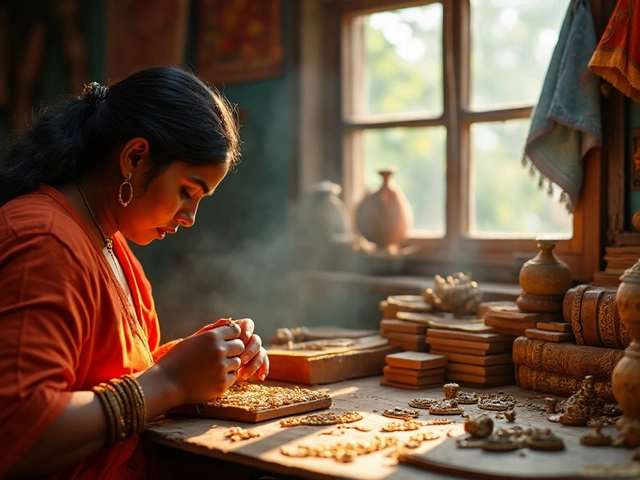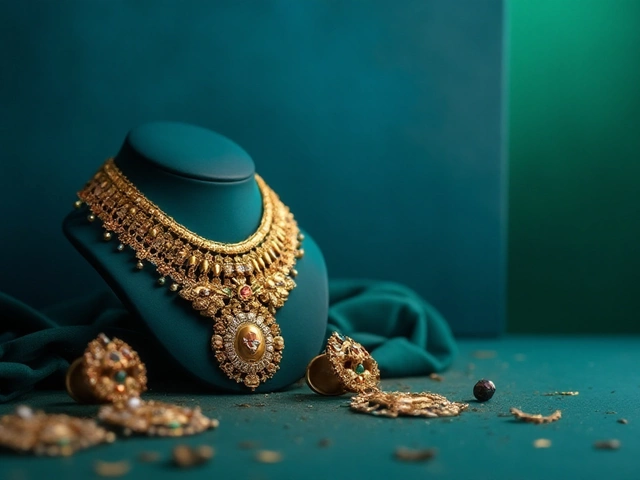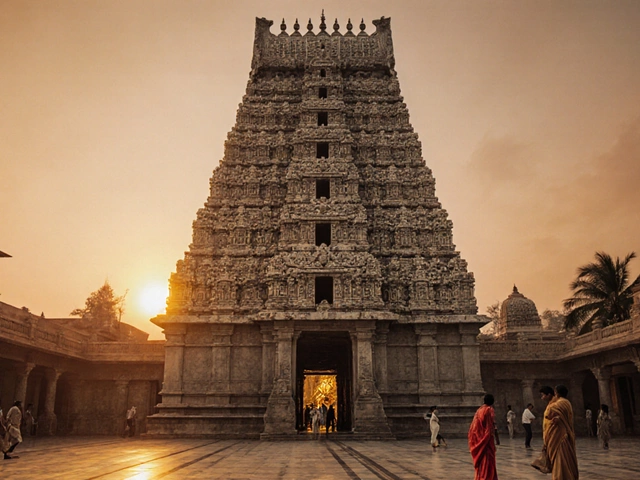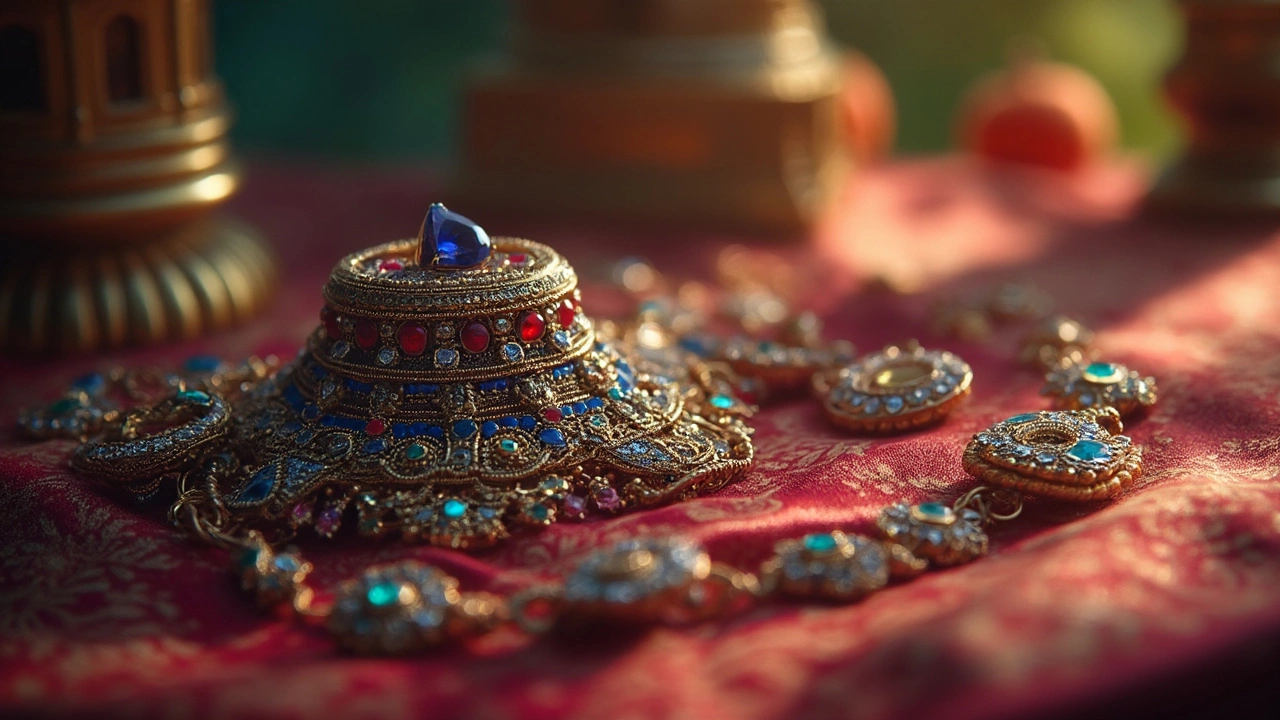
Walk into any Indian jewellery shop and you’ll hear someone whisper about the 'most powerful gemstone,' like it’s some hidden magic. People argue about blue sapphire and ruby as if they’re football rivals. But what exactly makes one gemstone more powerful than another in Vedic astrology? It’s less about the shiny factor and more about planetary energy, timing, and which stone fits your personal birth chart.
Temple jewellery in India is deeply tied to astrology. Folks choose gemstones because they think these stones can actually change their luck, boost their health, or flip their fortunes overnight. But before you rush to swap your ring, it pays to understand the real basics. Are you after something that stands out, or are you looking for real results?
If you want to know which gemstone tops the list for power, you need to ditch the myths and dig into how these stones actually work, who should wear them, and why their connection with temple jewellery isn’t just about looking good but also about tradition and belief.
- Why Gemstones Matter in Vedic Astrology
- Navaratna: The Big Nine Gems
- Blue Sapphire vs Ruby: The Clash of the Titans
- How Gemstones Get Their Power
- Practical Tips for Choosing and Wearing Gemstones
- Gemstones in Temple Jewellery: Tradition Meets Style
Why Gemstones Matter in Vedic Astrology
So, why do people in India trust gemstones for more than just bling? In Vedic astrology, each major planet is linked with a specific gemstone. The main idea is that wearing the right stone can boost the good vibes from planets that seem favorable in your chart or reduce the hassle from those causing trouble. For example, a blue sapphire for Saturn, a ruby for the Sun, or an emerald for Mercury.
Here’s the kicker—these choices aren’t made up on the spot. Vedic astrologers match gemstones to your birth chart, which is basically a planetary map drawn at the time you were born. The placement of planets in this chart is thought to affect your life in all sorts of ways—think jobs, relationships, health, even mood swings. If a planet is 'weak' or unfriendly, wearing its gemstone might give you a push in the right direction.
The use of gemstones isn’t just about ancient beliefs either. You’ll even find many trusted families in India who have their own jeweller for making custom gemstone rings after a detailed reading from an astrologer. Check out this quick match-up chart:
| Planet | Gemstone | Main Benefit (Believed) |
|---|---|---|
| Sun | Ruby | Boosts confidence, power |
| Moon | Pearl | Calms mind, brings peace |
| Mars | Red Coral | Increases energy and courage |
| Mercury | Emerald | Sharpens communication, intellect |
| Jupiter | Yellow Sapphire | Luck in education, money |
| Venus | Diamond | Helps love, beauty, creativity |
| Saturn | Blue Sapphire | Strengthens focus, helps career |
| Rahu | Hessonite Garnet | Cuts confusion, overcomes obstacles |
| Ketu | Cats Eye | Sharpens intuition, removes fear |
Some stones get a reputation because stories float around about quick wins or disasters after wearing them. Especially with the powerful gemstone blue sapphire (Neelam), people claim either instant success or the total opposite. That's why many won’t even touch a blue sapphire without a trial run—wrapped in cloth and worn for a week, just to be safe.
If you’re thinking of wearing a gemstone for its supposed benefits, don’t just pick one off the shelf. Get your chart checked, talk to someone who knows their stuff, and see if temple jewellery styles work for you. After all, if people have followed this for centuries, they must have seen something work.
Navaratna: The Big Nine Gems
If you've ever seen someone wearing a chunky ring with several colored stones, they’re probably sporting the Navaratna. This is a classic combo of nine powerful gems that, according to Vedic astrology, cover all the bases for planetary vibes. The word ‘Navaratna’ literally translates to ‘nine gems’ in Sanskrit.
Each gemstone in the Navaratna is linked to one of the major planets, and together, they're supposed to balance your energy and protect you from the bad stuff. Here’s what’s typically in the mix:
- Ruby (Sun)
- Pearl (Moon)
- Red Coral (Mars)
- Emerald (Mercury)
- Yellow Sapphire (Jupiter)
- Diamond (Venus)
- Blue Sapphire (Saturn)
- Hessonite (Rahu — North Node)
- Cat’s Eye (Ketu — South Node)
Wearing all nine at once is supposed to be like covering every base in a baseball game. According to astrologers, the Navaratna can give you protection from bad luck, boost health, improve finances, and keep your mind steady. But there’s a catch: it only works well if you’re not super-sensitive to any single planet’s energy. Otherwise, you risk throwing your balance off instead of fixing it.
If you’re curious about how these stones line up with the planets, check this quick table below:
| Planet | Gemstone | Color |
|---|---|---|
| Sun | Ruby | Deep red |
| Moon | Pearl | White |
| Mars | Red Coral | Red/Orange |
| Mercury | Emerald | Green |
| Jupiter | Yellow Sapphire | Yellow |
| Venus | Diamond | Colorless |
| Saturn | Blue Sapphire | Blue |
| Rahu (North Node) | Hessonite | Brownish orange |
| Ketu (South Node) | Cat’s Eye | Greyish green |
Navaratna rings and pendants are a big hit in temple jewellery too. They aren’t just pretty—they’re seen as wearable shields against bad luck. Still, before you slap one on, talk to an astrologer. Some folks get better results with a single stone, while others swear by the full set. The secret is finding what matches with your chart, not just what looks good with your outfit.
Blue Sapphire vs Ruby: The Clash of the Titans
When people talk about the most powerful gemstone in Vedic astrology, it usually boils down to two heavyweights: blue sapphire (Neelam) and ruby (Manik). Each has a serious reputation, but their powers and effects are totally different.
Blue sapphire is linked to Saturn, one of the most feared—and respected—planets. Saturn rules discipline, hard work, and karma. If it’s good in your horoscope, blue sapphire is supposed to bring quick results, sometimes in just weeks. We're talking about boosts in career, protection from bad luck, and sharper focus. But, here’s the thing: if blue sapphire doesn’t suit you, it can backfire hard. People have reported feeling anxious, facing sudden money loss, or even health issues if they wear it without proper advice. That's why astrologers always say to test blue sapphire for a few days before making it a daily thing.
Ruby is a whole different story. It represents the Sun. That means energy, status, leadership, and confidence. Ruby is said to lift self-esteem and clear out doubts, making it a go-to for anyone who wants to step up and lead. It’s considered safer than blue sapphire since the Sun is a steady force in most charts, and side effects from wearing ruby alone are rare.
Here's how these two stack up, side by side:
| Blue Sapphire (Neelam) | Ruby (Manik) | |
|---|---|---|
| Planet | Saturn (Shani) | Sun (Surya) |
| Main Benefits | Career growth, discipline, protection | Leadership, confidence, self-esteem |
| Risks | Only suits a few, side effects possible | Rarely harmful |
| Who Should Avoid | Anyone with weak Saturn or tough horoscope placements | Those with weak Sun in their chart |
| Tests Before Wearing? | Strongly advised | Not usually needed |
If you’re thinking of getting one, here are a few no-nonsense tips:
- Never buy these stones based on trends—get your horoscope checked first by someone who gets Vedic astrology.
- Genuine stones matter—fake sapphires and rubies are everywhere, especially in markets for temple jewellery.
- Look at the stone’s certification and clarity. A small, good-quality gem often works better than a big, bad one.
So, which one's truly more powerful? It depends on your birth chart. Blue sapphire acts fast but isn’t safe for everyone. Ruby gives a steady push but takes time to show its full effect. The real winner comes down to your personal fit, not just the stone’s name.
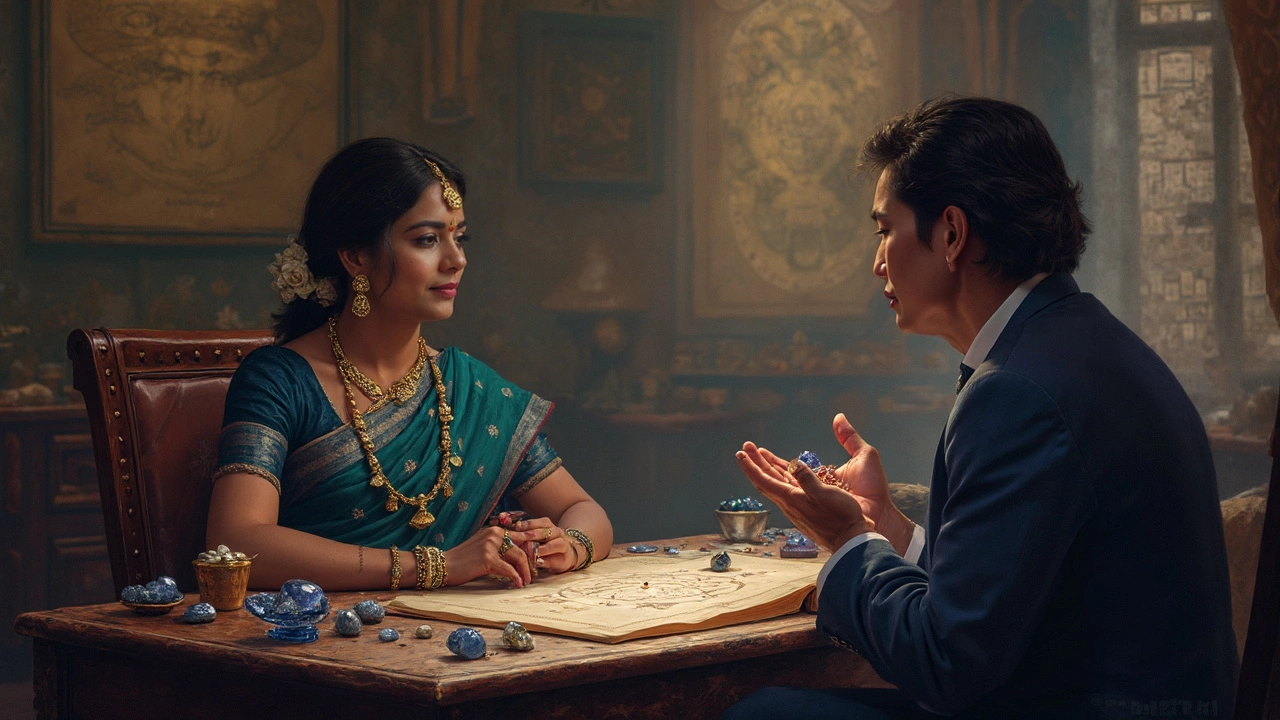
How Gemstones Get Their Power
People always ask, how can a rock do anything for me? Turns out, in Vedic astrology, it’s all about energy. Each planet is supposed to send out certain types of cosmic energy. These energies, good or bad, hit you at different times, depending on your birth chart. Gemstones are believed to work as filters or boosters—they either block bad stuff or boost the good coming from a specific planet.
Let’s get real—just wearing any old stone won’t do the trick. The gemstone needs to be:
- Genuine and untreated (fake stones are just for show, no impact).
- Of the right type and weight for your birth chart.
- Set in the correct metal (like gold, silver, or copper—there’s a reason for each).
- Worn on the right finger, on the right day and time (yes, the details matter, a lot).
Astrologers often calculate the exact carat and best day to start wearing the stone. Why? Because they believe it’s the only way the gemstone’s energy syncs with yours. Here’s a quick look at which planet matches which stone:
| Planet | Main Gemstone | Best Metal Setting |
|---|---|---|
| Sun | Ruby | Gold |
| Moon | Pearl | Silver |
| Mars | Red Coral | Copper |
| Mercury | Emerald | Gold |
| Jupiter | Yellow Sapphire | Gold |
| Venus | Diamond | Platinum/Silver |
| Saturn | Blue Sapphire | Silver |
| Rahu | Hessonite | Silver |
| Ketu | Cats Eye | Silver |
Another cool thing—natural, untreated stones are said to have way more energy than lab-made or heat-treated ones. That’s why ‘certified natural’ labels actually matter. One study in a top Indian gemmology journal in 2022 found untreated blue sapphires and rubies to score up to 30% higher in energy resonance tests compared to treated ones (which, honestly, isn’t something you can feel, but some swear by it).
So, if you’re planning to invest in a gemstone for its astrological power, go for natural, well-cut stones, and don’t skip the advice from a pro astrologer who knows their job. It’s the only way you get the most out of these supposedly ‘powerful’ gems.
Practical Tips for Choosing and Wearing Gemstones
Picking a gemstone isn’t just a fashion choice—especially if you’re serious about the benefits from Vedic astrology. You want to get it right, both for results and for your own safety. Here’s a breakdown of things that actually matter when you’re picking and wearing a gemstone.
- Powerful gemstone claims only work if the stone matches your birth chart. Get your horoscope checked by a legit Vedic astrologer—not your cousin who read a book once.
- Look at the gemstone’s clarity and color. No big cracks, cloudiness, or weird spots. Real stones with top quality will always be pricier, but you don’t want junk if you’re playing for results.
- Certified natural gemstones work better than the cheap synthetic or dyed ones. Always ask for a lab certificate—IGI and GIA are solid names for this in India.
- This sounds silly, but size matters. For rings, most astrologers suggest at least 2 carats for results. Anything smaller is mostly just for show.
- Metals count: Gold is for most stones like ruby, but silver is recommended for some like moonstone or pearl. Don’t just set your gem in whatever metal matches your clothes.
- Timing isn’t a superstition here. Gemstones are supposed to be worn on specific days and during certain moon phases for max effect. Like, wear blue sapphire on a Saturday morning after sunrise for Saturn, rubies on Sunday for the Sun.
Ever wondered how to wear temple jewellery with gemstones? Pick pieces that keep the stone in constant contact with your skin—necklaces, rings, or pendants. A stone tucked under layers of metal or dangling loose won’t have much effect.
Don’t forget about maintenance. Clean your gemstone regularly using mild soap and a soft brush. Stay away from harsh chemicals. Avoid scratches and bumps.
If you’re curious how certain gemstones line up with planets and the best metal to wear, here’s a handy cheat sheet:
| Gemstone | Associated Planet | Best Metal | Recommended Day |
|---|---|---|---|
| Ruby | Sun | Gold | Sunday |
| Blue Sapphire | Saturn | Silver | Saturday |
| Emerald | Mercury | Gold | Wednesday |
| Pearl | Moon | Silver | Monday |
| Yellow Sapphire | Jupiter | Gold | Thursday |
Buying the right gemstone goes beyond looks. Ask for details, certificates, and check connections to your astrology chart. Only then can you hope to get more than just compliments—maybe even a bit of real luck.
Gemstones in Temple Jewellery: Tradition Meets Style
Temple jewellery is basically the OG bling of India. Originally, it was made for deities in temples, decked out in serious gold with punchy gemstones, and over time, it made its way to regular folks. The main focus? Mixing deep tradition with eye-popping style, and, thanks to Vedic astrology, a dose of cosmic power too.
The real stars here are the so-called "Navaratna"—the Nine Gems. When jewellers design pieces for temple jewellery, these nine stones play a starring role. Let’s look at which gems you’ll spot most:
- Ruby (for the Sun)
- Pearl (for the Moon)
- Red coral (for Mars)
- Emerald (for Mercury)
- Yellow sapphire (for Jupiter)
- Diamond (for Venus)
- Blue sapphire (for Saturn)
- Hessonite (for Rahu, North Node)
- Cats Eye (for Ketu, South Node)
People don’t just wear these stones for looks—they’re hoping to grab some benefits this ancient system promises. For example, a lot of South Indian temple jewellery features powerful gemstone combos for maximum effect, both for looks and belief. Some pieces even use the classic Navaratna arrangement, which is said to balance all planetary energies at once.
Crafting temple jewellery isn’t quick work, either. Artisans still use hand tools and old-school methods. The gold base gives it durability and is considered auspicious, while the choice and setting of each gem reflect both taste and tradition.
Here’s a quick breakdown of popular temple jewellery gemstones and their usual purpose:
| Gemstone | Planet | Common Use |
|---|---|---|
| Ruby | Sun | Strength, leadership, confidence |
| Pearl | Moon | Calm, emotional balance |
| Blue Sapphire | Saturn | Discipline, focus, protection |
| Emerald | Mercury | Intellect, business sense |
If you’re buying, remember: fake or treated stones won’t do much, belief-wise or in Vedic astrology. Always pick certified natural stones, and for big rituals, check with someone who knows their stuff—like a temple priest or experienced jeweller. Also, temple jewellery isn’t just for weddings or festivals; pieces are now styled for modern outfits, giving you the power of tradition and a fresh look.


